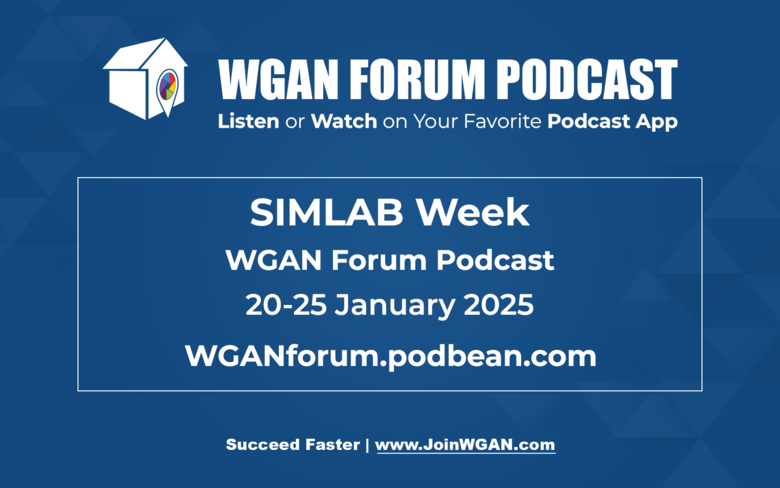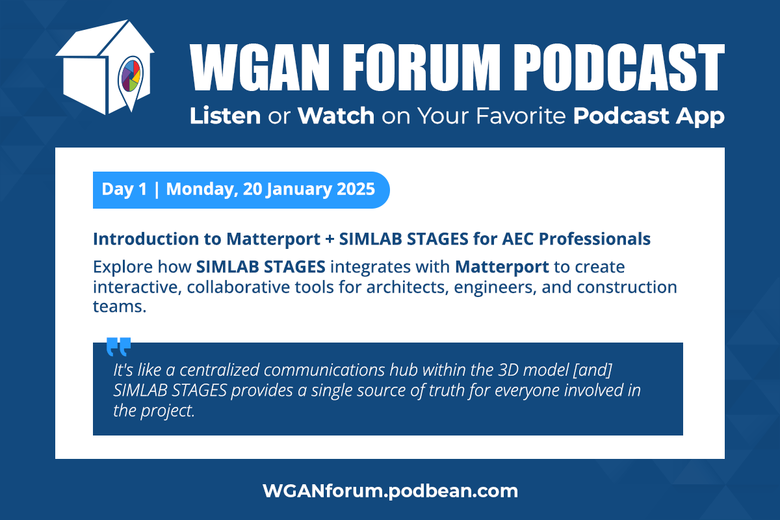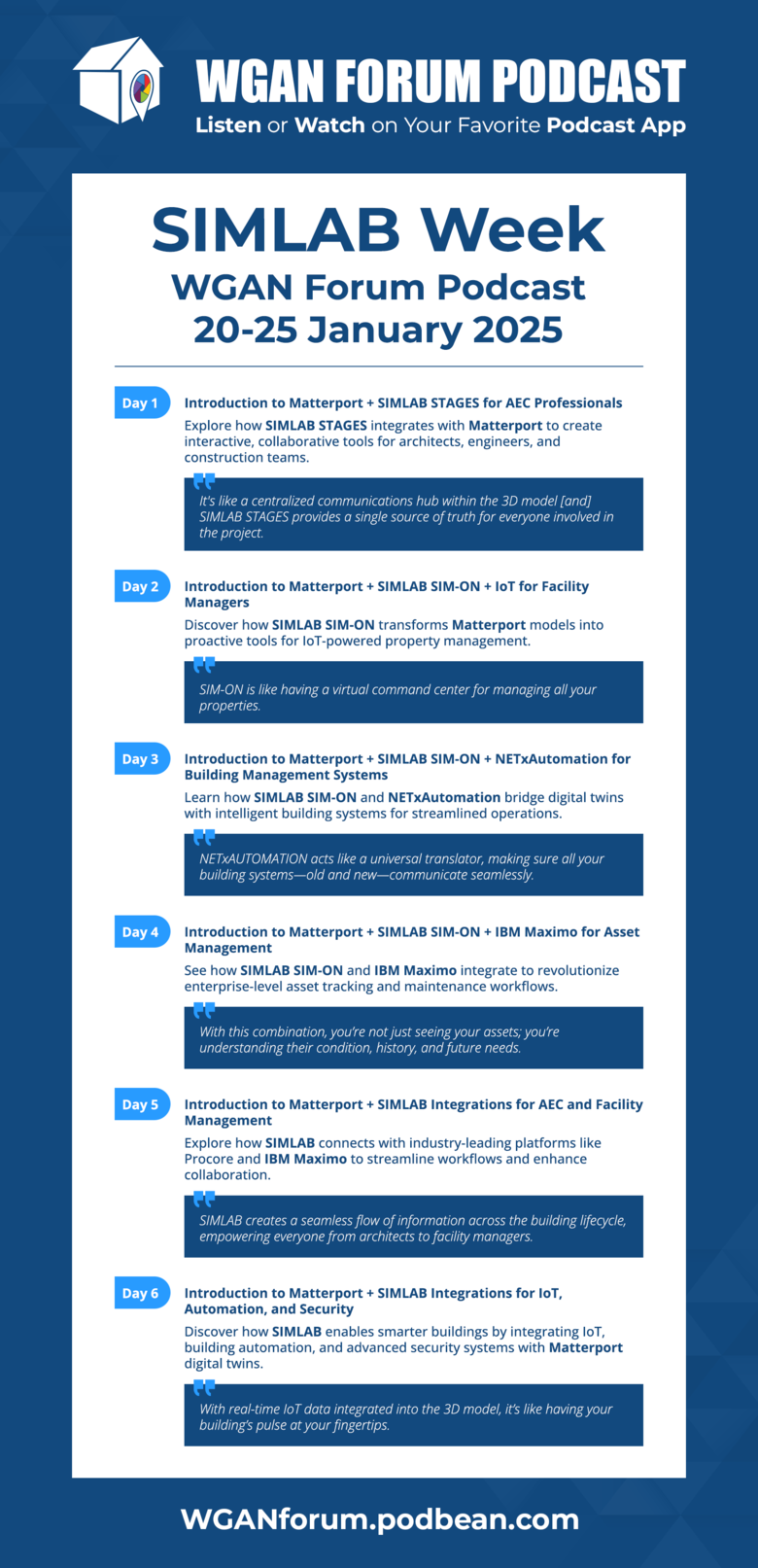Day 1: Intro to Matterport + SIMLAB STAGES for Construction Progress20640
Pages:
1
 WGAN Forum WGAN ForumFounder & WGAN-TV Podcast Host Atlanta, Georgia |
DanSmigrod private msg quote post Address this user | |
| SIMLAB is a WGAN Marketing Partner ---  WGAN Forum Podcast  WGAN Forum Podcast SIMLAB Week on WGAN Forum Podcast | Day 1: Intro to Matterport + SIMLAB STAGES for Construction Progress Documentation | Monday, 20 January 2025 WGAN Forum Podcast | SIMLAB Week on WGAN Forum Podcast | Day 1: Intro to Matterport + SIMLAB STAGES for Construction Progress Documentation | Monday, 20 January 2025 | @Jedrzej @SimlabSales @SIMLAB SIMLAB WEEK on WGAN Forum Podcast Day 1: Intro to Matterport + SIMLAB STAGES for Construction Progress Episode Summary Kicking off SIMLAB WEEK on the WGAN Forum Podcast today (Monday, 20 January 2025), this episode dives into the game-changing capabilities of Matterport and SIMLAB STAGES for architects, engineers, and construction professionals. Listen how these innovative tools revolutionize construction progress documentation, offering unparalleled precision, efficiency, and collaboration for projects. Listeners will discover how combining the Matterport 3D digital twin scanning tech with SIMLAB STAGES transforms the way AEC teams manage workflows, track progress, and deliver results. Whether you're a seasoned Matterport Service Provider or new to digital construction tools, this episode promises insights that will leave you wondering how you ever managed commercial construction projects without them. Tune in (above) for an engaging discussion packed with practical applications and expert perspectives to set the stage for the rest of SIMLAB WEEK on WGAN Forum Podcast. SIMLAB Links 1. SIMLAB 2. SIMLAB STAGES 3. SIMLAB SIM-ON Transcript - [Host 1] Alright, so this week we're doing a deep dive into something pretty game changing for architects, engineers, and construction pros. All of you in the AEC space are going to want to listen up, because we're talking about Matterport and the SIMLAB STAGES. And you know, by the end of the week you'll be wondering how you ever manage projects without it. - [Host 2] Yeah, you know, it's really one of those technologies that clicks once you see it in action. I mean, Matterport, they've been making waves in AEC for a while now, but SIMLAB STAGES, it really takes those 3D scans to a whole new level. - [Host 1] And that's what we're unpacking today. What happens when you combine that power of Matterport's detailed 3D capture with SIMLAB's, innovative software? I mean, think of it like this. Matterport gives you the snapshot, you know, that incredibly detailed digital replica of your site. And then SIMLAB STAGES turns that snapshot into a dynamic interactive tool. You can really manage every step of the project from it. - [Host 2] Yeah, it's not just about pretty pictures. SIMLAB STAGES brings all your project data together, blueprints, schedules, models, you name it. It's all woven into that Matterport 3D environment. - [Host 1] Okay, so now we have this amazing 3D model of our project. What exactly makes SIMLAB STAGES so special? There are a few key features that have the whole AEC world buzzing. - [Host 2] Yeah, and I think the one that gets the most wow reactions is the timeline. It's like having a time machine for your project. - [Host 1] So imagine this, you're meeting with a client and they're concerned about the progress of a specific area and you can pull up the timeline and flip back through the different stages of construction and you can show them exactly what's been done, when it was done and by whom. It's all right there visually laid out in the 3D model. - [Host 2] And the best part is, you're not just relying on, you know, stack reports or photos. You're giving them an immersive experience. Something that's easy to understand, even for clients who aren't familiar with, you know, construction lingo or those complex blueprints. - [Host 1] Right, and speaking of avoiding those lost in translation moments, how many times have you run into issues because of discrepancies between different versions of plans or models? - [Host 2] Oh, countless times. It's a nightmare trying to figure out which version is the most up-to-date, especially on those large projects with multiple stakeholders. - [Host 1] Well, SIMLAB STAGES has this feature that solves that problem beautifully, split screen. You can pull up any two project files side by side, compare them in real time, right within the 3D model. - [Host 2] And it's not just about comparing different versions of the same file. You could have like a BIM model on one side and a Matterport scan from a specific date on the other. It's so useful for like identifying potential clashes or verifying that installations match the as-built conditions. - [Host 1] Right, now, this next feature, something I wish I had on every project I've ever worked on, the collaboration toolkit. So this takes the concept of MatterTags, which Matterport users are probably already familiar with, and supercharges it. - [Host 2] It's like a centralized communication hub within the 3D model. You need to flag an issue. Just drop a pin on the exact location and add a note. You can add a photo, even a voice memo. - [Host 1] And because it's all linked to that specific point in the model, there's no more confusion about what you're referring to. You can even assign tasks to specific team members, ensuring accountability and keeping everyone in the loop. - [Host 2] And what I find particularly impressive is the level of detail you can capture. Let's say you're inspecting electrical installations. You can take a photo of the wiring, tag it with the relevant code requirements, and even attach the manufacturer specs, all in one place. - [Host 1] It's like having a digital paper trail. Every aspect of your project organized and accessible within the 3D environment. - [Host 2] And this might seem like a small detail, but it integrates seamlessly with platforms like Procore. And that's huge for streamlining workflows and avoiding those dreaded data silos. - [Host 1] Okay, so we've covered three of the most talked about features, but let's shift gears for a moment. Let's talk about why this should matter to you, the busy AEC professional juggling deadlines, budgets and demanding clients. What are the real world benefits of using SIMLAB STAGES? - [Host 2] Well, the first one that jumps out at me is risk reduction. Think about all the potential headaches that come with construction projects, delays, rework, disputes. SIMLAB STAGES helps you get ahead of those issues by providing clear visual documentation every step of the way. - [Host 1] It's like having an extra set of eyes on the job site, but these eyes can see through walls and rewind time. You catch those small errors before they become big problems. - [Host 2] Exactly, and that brings us to the second major benefit, cost savings. Time is money in construction. And SIMLAB STAGES helps you save both: fewer site visits, less rework, faster dispute resolution. It all adds up to a more efficient and profitable project. - [Host 1] Yeah, and let's not forget the client side of things. Being able to walk a client through the project virtually, show them progress in a way they can grasp instantly. That builds trust and strengthens relationships. - [Host 2] Absolutely. And the third benefit it builds on that trust. Communication. SIMLAB STAGES provides a single source of truth for everyone involved in the project. No more searching through emails or trying to decipher handwritten notes. Everything is right there, clear and accessible in the model. - [Host 1] You know what that means. Fewer miscommunications, fewer conflicts, and a smoother, more collaborative project overall. - [Host 2] It's about moving away from those "he said, she said" situations and creating a shared understanding of the project's status and progress. It's one thing to talk about these benefits, you know, just in theory, but what really makes it click for me is seeing how SIMLAB STAGES is used on real projects. - [Host 1] I know what you mean. The interview we're working from had some really great real world examples. One that stuck with me was how a large hospital used SIMLAB STAGES, not just during construction, but for, you know, ongoing facility management. - [Host 2] Oh yeah, hospitals. There's so complex, so many interconnected systems, constant changes happening. I can see how valuable a tool like this would be for them. - [Host 1] Absolutely. They talked about how having all the building data centralized and easily accessible within the Matterport model was a game changer. They could instantly locate specific pieces of equipment. - [Host 2] Yeah. - [Host 1] Know, access maintenance records, see when filters were last changed, all without having to dig through mountains of paperwork. - [Host 2] Right, and think about the safety implications in a hospital. Let's say there's an emergency repair. Maintenance crews can use SIMLAB STAGES to quickly understand the problem. You know, see where the shutoff valves are, virtually walk through the space. They can plan the most efficient route and minimize disruption to patient care. - [Host 1] They even mentioned that SIMLAB STAGES help reduce those onsite visits from specialists. So that saves time and money and sometimes it can even get those critical systems back online faster. - [Host 2] It's pretty amazing to think how this technology can impact everything from operational efficiency to even patient outcomes. Speaking of diverse applications, they also mentioned how retailers are using the timeline feature in some really creative ways. - [Host 1] Oh yeah. This is where you can see how powerful it is to visualize change over time. - [Host 2] Yeah. - [Host 1] They gave this example of a retail chain that was always updating their store layouts and displays. With SIMLAB STAGES, they could track those changes, see how different layouts impacted customer flow, and even compare sales data to specific display arrangements. - [Host 2] Yeah, it's like having a historical record of how the store has evolved, but you're not just looking back. You can use that data to make decisions about future renovations, product placement, even marketing campaigns. - [Host 1] Right, and they also talk about how SIMLAB STAGES made communication between store managers, maintenance teams, and contractors, so much easier. Everyone has access to the same up-to-date information and that minimizes confusion and all that back and forth trying to explain a problem over the phone. - [Host 2] And you know, we're really just scratching the surface here. These large scale applications are impressive, but SIMLAB STAGES isn't just for massive hospitals or retail chains. - [Host 1] Exactly. They emphasize that this technology is scalable to fit any project size. Even if you're working on a smaller residential renovation or a small commercial build, you can still reap the benefits of a centralized visual platform for managing your project. - [Host 2] I mean, think how much easier it would be to communicate with clients if you could just walk them through a 3D model of their home renovation, show them exactly where the new plumbing lines will run, or how the lighting will be installed. - [Host 1] Yeah, you can even use it to keep track of those finished selections, appliance specifications and warranty information. Basically a digital record of every decision made throughout the project. - [Host 2] Right, and let's be real, how many times have we wished we had a detailed record of, I don't know, where wires were run or what type of insulation was used years after a project is finished? SIMLAB STAGES, it's like creating a living archive of your work. - [Host 1] So we've established that SIMLAB STAGES has some really compelling benefits and that it can be used across a wide range of projects. But let's be real for a second. No technology is perfect and there are always challenges when implementing something new. - [Host 2] Oh, for sure. And the interview did touch on some of those hurdles that users might face. The first one is that learning curve. Even with user-friendly software, there's always going to be that period of adjustment while your team gets familiar with the platform and all its features. - [Host 1] And then there's the data Management side of things. You know, with SIMLAB STAGES, you're bringing all this information together from various sources, blueprints, models, scans, schedules. It can be a lot to handle. - [Host 2] Yeah, absolutely. You have to establish clear processes for organizing and managing that data from the beginning, like who has access to what, how do you make sure everything is consistent across those different file types? Those are all important things to consider upfront. - [Host 1] And of course, security is crucial. When you're dealing with all that sensitive project information, especially in AEC, with contracts, budgets, and designs involved, you need to make sure the data is safe and protected. - [Host 2] Right. And SIMLAB takes security very seriously, but it's still important for users to understand those security protocols and implement their own safeguards. - [Host 1] Now, another potential challenge they mentioned was the human element, change management. Let's face it, people can be resistant to new technologies, especially if it disrupts those established workflows. - [Host 2] Oh yeah, absolutely. That's where clear communication and training are key. You need to show your team why SIMLAB STAGES is valuable, how it'll make their lives easier and provide the support to ensure a smooth transition. - [Host 1] It's not just teaching them how to use the software. It's about fostering a culture of collaboration and data-driven decision making. - [Host 2] Hmm, exactly. And lastly, let's talk about the cost. SIMLAB STAGES offers a lot of value, but it's not free. For smaller firms, or individual professionals, that initial investment might seem like a lot. - [Host 1] It's true, but I think it's important to look at it as an investment, not an expense. Think about the potential cost savings we talked about earlier. Fewer site visits, less rework, faster project completion. Those savings can offset the cost of the software pretty quickly. - [Host 2] Yeah. And as digital twin technology becomes more mainstream, we can expect those costs to come down. Accessibility will increase too, which will make it even more appealing to a wider range of users. - [Host 1] So there are challenges, but the overall takeaway is that SIMLAB STAGES is a powerful tool. It offers a lot to the AEC industry. It's not a fad, it's a shift in how we approach construction progress, documentation, and collaboration. - [Host 2] We've been talking about the present state of SIMLAB STAGES, but what really gets me excited is thinking about the future. Where could this technology go in the next, I don't know, five, 10 years? - [Host 1] That's where things get really interesting. I mean, it's like we're at the edge of a technological revolution in the AEC industry and SIMLAB STAGES is like right at the forefront. - [Host 2] One thing that really caught my eye was the integration with platforms like Procore. It hints at a future where data flows seamlessly between all the different tools we use. - [Host 1] You're talking about a world where your BIM model, your project schedule, your cost estimates, even your drone survey data, all connected, all accessible right there in that shared 3D environment. - [Host 2] Exactly, no more exporting, importing, all those version control nightmares. Just a single source of truth and everyone's working from it in real-time. - [Host 1] And that's where AI comes in. With all that data, centralized, standardized, AI could start to analyze patterns, identify potential risks, even optimized designs for cost and sustainability. - [Host 2] I mean, we could be looking at a future where buildings are practically designing themselves, and you know, humans would just be there to guide the process. - [Host 1] That raises some big questions about the role of architects and engineers in the future. Will we become like conductors, you know, orchestrating the flow of data, making those high level decisions, while AI handles the technical details? - [Host 2] Yeah, that's a possibility. But I still think human creativity, that intuition, will always be crucial. Technology can help for sure, but it can't replace the artistry and problem solving, the things that architects and engineers bring to the table. - [Host 1] And what about the impact on sustainability? We're already seeing how digital twins help design more energy efficient buildings. But what if we take that a step further? - [Host 2] What if you used SIMLAB STAGES to simulate different building materials, systems and operational scenarios? You know, find the most sustainable solutions. You could even monitor building performance over time. Make adjustments to optimize energy consumption, reduce the environmental impact. - [Host 1] Speaking of real-time monitoring, what about disaster preparedness? Imagine having a digital twin of an entire city. Emergency responders could use it to simulate scenarios, plan evacuation, routes, even assess damage after a natural disaster. - [Host 2] It could save lives and reduce the impact of those events. And it's not just about reacting to disasters, it's about building resilience right from the start. - [Host 1] We talked earlier about homeowners using digital twins to manage their properties. What if we scaled that up to entire neighborhoods, even cities? - [Host 1] It would be like this virtual town square, where residents access information, connect and participate in decisions. - [Host 1] I mean, we could be looking at a future where the lines between the physical and digital world really start to blur, creating more connected, informed and engaged communities. - [Host 2] It's a powerful vision, and SIMLAB STAGES, with its focus on collaboration, communication and accessibility, well, it's making it happen. - [Host 1] It's been incredible to explore SIMLAB STAGES with you today. It's clear that it's more than just a tool. It's a glimpse into the future of the built environment, - [Host 2] A future where buildings are smarter, more efficient, and connected to the people who use them. A future where information is accessible and everyone can participate in shaping the world around them. - [Host 1] So if you're in the a AEC space and you haven't already, take a look at SIMLAB STAGES. Check out their website at www.SIMLABinc.com and select contact us to connect with their team. - [Host 2] And if you want to see SIMLAB STAGES in action, check out WGN-TV's podcast episodes. You can find them at: WGAN.INFO/SIMLABonWGAN They really go deep into those use cases and show how it's transforming real projects. - [Host 1] It's been an amazing journey exploring SIMLAB STAGES. We hope you get some great insights and inspiration along the way. Keep innovating, collaborating, and pushing those boundaries of what's possible in the built environment.  WGAN Forum Podcast SIMLAB Links 1. SIMLAB 2. SIMLAB STAGES 3. SIMLAB SIM-ON |
||
| Post 1 • IP flag post | ||

|
Buster6070 private msg quote post Address this user | |
| Are you able to embed this on a website? I have a builder about to put up condos and is interested in using this to showcase there process online to the public. | ||
| Post 2 • IP flag post | ||
 WGAN Forum WGAN ForumFounder & WGAN-TV Podcast Host Atlanta, Georgia |
DanSmigrod private msg quote post Address this user | |
| @Buster6070 Awesome use-case by your builder. Yes, SIMLAB provides public links for their enhanced Matterport tours, which can be embedded into websites. These links allow you to showcase advanced features such as construction monitoring timelines, facility management tools, and IoT integrations within the Matterport environment. To obtain an embeddable link, you can use the sharing options within the SIMLAB platform, which generate a URL or embed code suitable for website. ——- Would you like an intro to SIMLAB via email? Best, Dan |
||
| Post 3 • IP flag post | ||
Pages:
1This topic is archived. Start new topic?

















